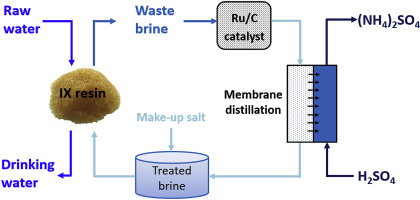Water Research ( IF 11.4 ) Pub Date : 2020-03-05 , DOI: 10.1016/j.watres.2020.115688 Xiangchen Huo , Johan Vanneste , Tzahi Y. Cath , Timothy J. Strathmann

|
Ion exchange is widely used to treat nitrate-contaminated groundwater, but high salt usage for resin regeneration and management of waste brine residuals increase treatment costs and add environmental burdens. Development of palladium-based catalytic nitrate treatment systems for brine treatment and reuse has showed promising activity for nitrate reduction and selectivity towards the N2 over the alternative product ammonia, but this strategy overlooks the potential value of nitrogen resources. Here, we evaluated a hybrid catalytic hydrogenation/membrane distillation process for nitrogen resource recovery during treatment and reuse of nitrate-contaminated waste ion exchange brines. In the first step of the hybrid process, a Ru/C catalyst with high selectivity towards ammonia was found to be effective for nitrate hydrogenation under conditions representative of waste brines, including expected salt buildup that would occur with repeated brine reuse cycles. The apparent rate constants normalized to metal mass (0.30 ± 0.03 mM min−1 gRu−1 under baseline condition) were comparable to the state-of-the-art bimetallic Pd catalyst. In the second stage of the hybrid process, membrane distillation was applied to recover the ammonia product from the brine matrix, capturing nitrogen as ammonium sulfate, a commercial fertilizer product. Solution pH significantly influenced the rate of ammonia mass transfer through the gas-permeable membrane by controlling the fraction of free ammonia species (NH3) present in the solution. The rate of ammonia recovery was not affected by increasing salt levels in the brine, indicating the feasibility of membrane distillation for recovering ammonia over repeated reuse cycles. Finally, high rates of nitrate hydrogenation (apparent rate constant 1.80 ± 0.04 mM min−1 gRu−1) and ammonia recovery (overall mass transfer coefficient 0.20 m h−1) with the hybrid treatment process were demonstrated when treating a real waste ion exchange brine obtained from a drinking water utility. These findings introduce an innovative strategy for recycling waste ion exchange brine while simultaneously recovering potentially valuable nitrogen resources when treating contaminated groundwater.
中文翻译:

从硝酸盐污染的废离子交换盐水中回收氮资源的混合催化加氢/膜蒸馏工艺
离子交换已广泛用于处理受硝酸盐污染的地下水,但是高盐用量用于树脂再生和处理废盐水残留物会增加处理成本并增加环境负担。用于盐水处理和再利用的钯基催化硝酸盐处理系统的开发显示出有希望的硝酸盐还原活性和对N 2的选择性替代替代产品氨,但该策略忽略了氮资源的潜在价值。在这里,我们评估了一种混合催化加氢/膜蒸馏工艺,用于在硝酸盐污染的废离子交换盐水的处理和再利用过程中回收氮资源。在混合工艺的第一步中,发现对氨具有高选择性的Ru / C催化剂可在代表废盐水的条件下有效地硝酸盐加氢,包括在重复使用盐水后可能发生的盐堆积。表观速率常数归一化为金属质量(0.30±0.03 mM min -1 g Ru -1在基线条件下)可与最新的双金属钯催化剂相比。在混合工艺的第二阶段,应用膜蒸馏从盐水基质中回收氨产品,并以商业化肥产品硫酸铵的形式捕获氮。溶液的pH通过控制溶液中存在的游离氨类(NH 3)的比例,显着影响了氨气通过透气膜的传质速率。氨水的回收率不受盐水中盐浓度增加的影响,这表明膜蒸馏在重复使用循环中回收氨气的可行性。最后,硝酸盐氢化率高(表观速率常数1.80±0.04 mM min -1 g Ru -1当处理从饮用水公司获得的实际废离子交换盐水时,用混合处理工艺证明了氨水的回收率(总传质系数为0.20 m h -1)。这些发现引入了一种创新的策略,用于回收废弃的离子交换盐水,同时在处理受污染的地下水时同时回收潜在有价值的氮资源。











































 京公网安备 11010802027423号
京公网安备 11010802027423号